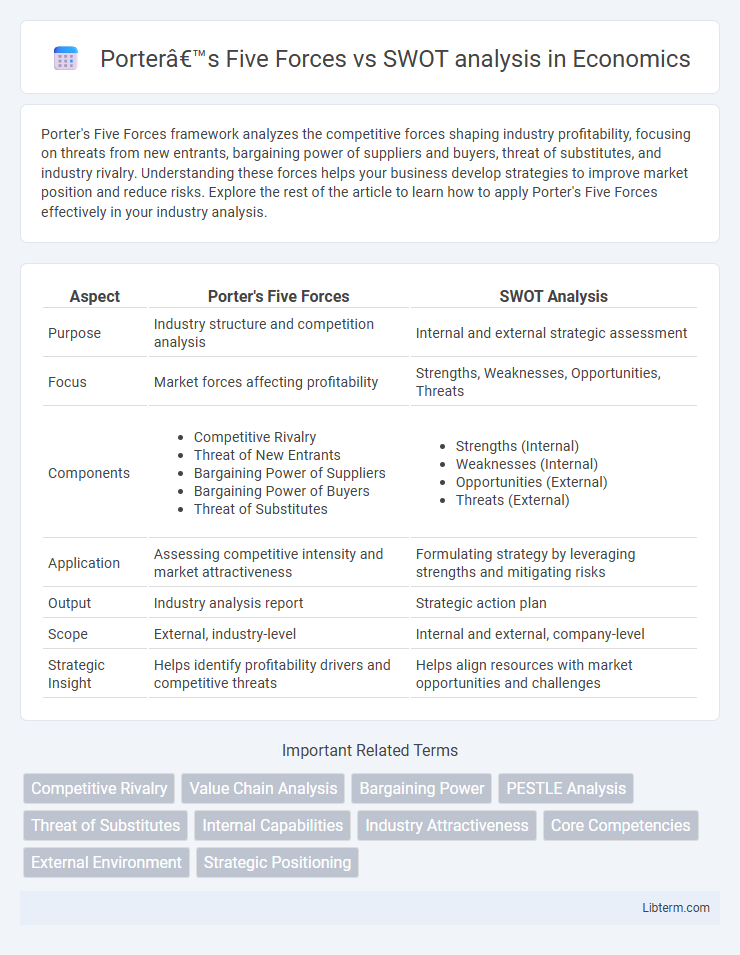Porter's Five Forces framework analyzes the competitive forces shaping industry profitability, focusing on threats from new entrants, bargaining power of suppliers and buyers, threat of substitutes, and industry rivalry. Understanding these forces helps your business develop strategies to improve market position and reduce risks. Explore the rest of the article to learn how to apply Porter's Five Forces effectively in your industry analysis.
Table of Comparison
| Aspect | Porter's Five Forces | SWOT Analysis |
|---|---|---|
| Purpose | Industry structure and competition analysis | Internal and external strategic assessment |
| Focus | Market forces affecting profitability | Strengths, Weaknesses, Opportunities, Threats |
| Components |
|
|
| Application | Assessing competitive intensity and market attractiveness | Formulating strategy by leveraging strengths and mitigating risks |
| Output | Industry analysis report | Strategic action plan |
| Scope | External, industry-level | Internal and external, company-level |
| Strategic Insight | Helps identify profitability drivers and competitive threats | Helps align resources with market opportunities and challenges |
Introduction to Porter’s Five Forces and SWOT Analysis
Porter's Five Forces framework analyzes industry competitiveness through five key forces: competitive rivalry, threat of new entrants, bargaining power of suppliers, bargaining power of buyers, and threat of substitutes. SWOT analysis evaluates internal strengths and weaknesses alongside external opportunities and threats to identify strategic positioning. Both models aid strategic planning, with Porter's Five Forces focusing on external industry dynamics and SWOT providing a comprehensive internal-external assessment.
Defining Porter’s Five Forces
Porter's Five Forces is a strategic framework that analyzes five key competitive forces shaping industry dynamics: competitive rivalry, threat of new entrants, threat of substitutes, bargaining power of suppliers, and bargaining power of buyers. This model helps businesses assess market attractiveness and develop strategies to improve competitive advantage by understanding the intensity and impact of each force. Unlike SWOT analysis, which examines internal strengths and weaknesses alongside external opportunities and threats, Porter's Five Forces exclusively focuses on external competitive pressures influencing industry profitability.
Understanding the SWOT Analysis Framework
The SWOT analysis framework evaluates an organization's internal strengths and weaknesses alongside external opportunities and threats, providing a comprehensive overview for strategic planning. Unlike Porter's Five Forces, which centers on assessing industry competitiveness through factors like rivalry and supplier power, SWOT emphasizes internal capabilities and external possibilities. This framework helps businesses identify areas for growth and risk mitigation by systematically analyzing both internal and external environments.
Key Components of Porter’s Five Forces
Porter's Five Forces framework analyzes industry competitiveness through five key components: competitive rivalry, threat of new entrants, bargaining power of suppliers, bargaining power of buyers, and threat of substitute products or services. This model helps businesses assess external factors influencing market dynamics and profitability. Unlike SWOT analysis, which evaluates internal strengths, weaknesses, opportunities, and threats, Porter's Five Forces concentrates specifically on external competitive pressures.
Strengths and Limitations of SWOT Analysis
SWOT analysis offers a straightforward framework for identifying internal strengths and weaknesses alongside external opportunities and threats, enabling strategic planning and decision-making. Its primary strength lies in its simplicity and versatility for businesses across industries, but it often lacks the depth required for competitive market analysis compared to Porter's Five Forces. Limitations include subjectivity in evaluation, potential for oversimplification, and insufficient focus on dynamic market forces, which may lead to incomplete strategic insights.
Comparing Strategic Objectives: Five Forces vs. SWOT
Porter's Five Forces analysis focuses on evaluating industry competitiveness by examining the bargaining power of suppliers and buyers, threat of new entrants, threat of substitutes, and competitive rivalry to formulate strategies that enhance market positioning and profitability. In contrast, SWOT analysis identifies internal strengths and weaknesses alongside external opportunities and threats to develop comprehensive, adaptable strategic plans that leverage organizational capabilities and mitigate risks. While Five Forces primarily targets external industry dynamics to establish competitive advantage, SWOT provides a holistic view integrating both internal and external factors for strategic decision-making.
Ideal Use Cases for Porter’s Five Forces
Porter's Five Forces is ideal for analyzing industry competitiveness and market attractiveness by examining supplier power, buyer power, threat of new entrants, threat of substitutes, and competitive rivalry. It excels in strategic planning for businesses entering new markets or assessing industry profitability and barriers to entry. Compared to SWOT analysis, which evaluates internal strengths, weaknesses, opportunities, and threats, Porter's framework provides a deeper understanding of external forces shaping industry dynamics.
When to Choose SWOT Analysis for Decision-Making
Choose SWOT analysis for decision-making when evaluating internal strengths and weaknesses alongside external opportunities and threats to develop strategic initiatives. It is especially useful in the early stages of business planning or product development to identify factors that directly impact organizational capabilities and market positioning. SWOT analysis provides a comprehensive overview to support decisions focused on leveraging core competencies and addressing potential challenges.
Integrating Porter’s Five Forces and SWOT for Comprehensive Insights
Integrating Porter's Five Forces with SWOT analysis provides a holistic view of a business's strategic landscape by combining external industry dynamics with internal capabilities and weaknesses. Porter's Five Forces evaluates competitive pressures such as rivalry, supplier power, buyer power, threat of substitutes, and new entrants, which complement SWOT's internal analysis of Strengths, Weaknesses, Opportunities, and Threats. Leveraging insights from both frameworks enables companies to develop robust strategies that exploit market opportunities, mitigate competitive threats, and align core strengths with industry forces for sustainable advantage.
Conclusion: Selecting the Right Analytical Tool for Business Strategy
Porter's Five Forces provides a detailed industry and competitive environment analysis, focusing on external market factors that influence profitability. SWOT analysis offers a broader internal and external perspective by identifying strengths, weaknesses, opportunities, and threats, facilitating strategic decision-making. Businesses should choose Porter's Five Forces when evaluating industry competition and use SWOT analysis for comprehensive strategic planning and internal assessment.
Porter’s Five Forces Infographic

 libterm.com
libterm.com